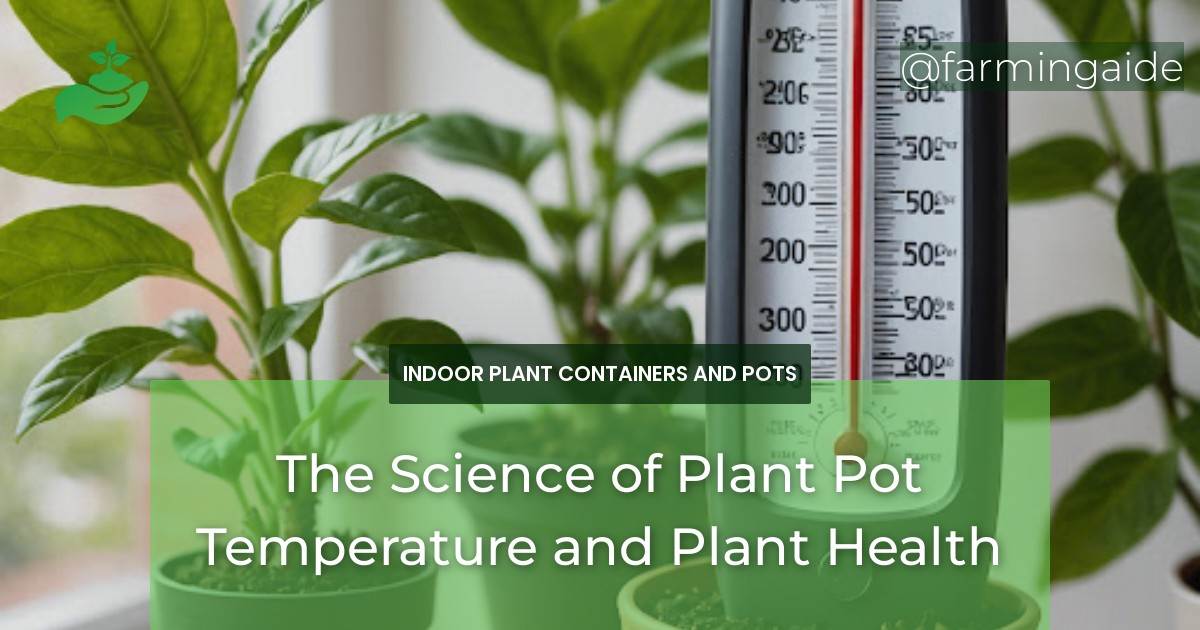The Science of Plant Pot Temperature and Plant Health: Unraveling the Mysteries
When it comes to indoor gardening, many of us focus on providing our plants with the right amount of water, sunlight, and nutrients. However, there’s another crucial factor that often gets overlooked: plant pot temperature. The temperature of the pot can significantly impact plant growth, health, and overall well-being. In this article, we’ll delve into the science of plant pot temperature, exploring its effects on plant health, ideal temperature ranges for different plants, and innovative solutions for temperature management.
Key Takeaways
- Plant pot temperature affects plant growth, health, and stress levels.
- Ideal pot temperatures vary depending on the plant species.
- Temperature fluctuations can lead to plant stress and disease.
- Regular temperature monitoring and regulation are crucial for optimal plant health.
- Smart pots and advanced temperature control systems can optimize plant growth.
Understanding Plant Pot Temperature
Plant pot temperature refers to the temperature of the soil and potting medium surrounding the roots of the plant. This temperature can be affected by various factors, including the type of potting material, soil moisture, and ambient temperature. Understanding the ideal temperature range for your plants is essential, as it can significantly impact their growth, development, and overall health.
Factors Affecting Pot Temperature
Several factors can influence the temperature of your plant pot, including:
- Potting material: Different materials, such as ceramic, plastic, or clay, can absorb and retain heat differently.
- Soil moisture: Soil moisture levels can affect the temperature of the pot, with drier soil leading to higher temperatures.
- Ambient temperature: The surrounding air temperature can influence the pot temperature, especially in extreme environments.
- Insulation: The level of insulation around the pot can also impact the temperature, with better insulation retaining heat.
How Temperature Influences Plant Growth
Temperature plays a critical role in plant growth and development. Optimal temperatures can enhance growth, while extreme temperatures can lead to stress, disease, and even death. Here are some ways temperature affects plant growth:
- Metabolic rate: Temperature influences the rate of metabolic processes, such as photosynthesis and respiration.
- Water uptake: Temperature affects the rate of water uptake, with optimal temperatures facilitating efficient water absorption.
- Hormone regulation: Temperature can impact hormone production, influencing growth and development.
Ideal Pot Temperatures for Different Plants
Just like humans, plants have unique temperature preferences. Understanding the ideal temperature range for your plants is crucial for optimal growth and health.
ALSO READ
Cool-Weather Plants
Cool-weather plants, such as lettuce and spinach, thrive in cooler temperatures between 60°F to 70°F (15°C to 21°C). These plants often suffer in high temperatures, making it essential to maintain a cooler environment.
Warm-Weather Plants
Warm-weather plants, such as tomatoes and peppers, prefer temperatures between 75°F to 85°F (24°C to 30°C). These plants often require higher temperatures to thrive.
| Plant Type | Ideal Temperature Range (°F) |
|---|---|
| Cool-weather plants (lettuce, spinach) | 60-70°F (15-21°C) |
| Warm-weather plants (tomatoes, peppers) | 75-85°F (24-30°C) |
Monitoring and Controlling Pot Temperature
Regular temperature monitoring is crucial for maintaining optimal plant health. Here are some tools and techniques for measuring and regulating pot temperature:
ALSO READ
Tools for Temperature Measurement
There are various tools available for measuring pot temperature, including:
- Digital thermometers: Accurate and easy to use, digital thermometers provide instant readings.
- Infrared thermometers: Non-invasive and quick, infrared thermometers measure temperature without disturbing the soil.
- Smart sensors: Advanced sensors can monitor temperature, humidity, and other environmental factors, providing real-time data.
Techniques for Temperature Regulation
Once you’ve measured the temperature, it’s essential to regulate it to optimal levels. Here are some techniques for temperature control:
- Insulation: Improve pot insulation to retain or release heat as needed.
- Shading: Provide shade to reduce ambient temperature and prevent overheating.
- Heating or cooling systems: Implement heating or cooling systems, such as heat mats or cooling pads, to maintain optimal temperatures.
Effects of Temperature Fluctuations on Plant Health
Temperature fluctuations can lead to plant stress, disease, and even death. Understanding the effects of temperature changes is crucial for maintaining optimal plant health.
Stress and Disease Caused by Temperature Changes
Temperature fluctuations can cause:
- Stress: Temperature changes can lead to plant stress, reducing growth and increasing susceptibility to disease.
- Disease: Fungal diseases, such as root rot, can thrive in extreme temperatures, compromising plant health.
Strategies for Mitigating Temperature Stress
To mitigate temperature stress, try:
- Gradual temperature changes: Avoid sudden temperature fluctuations by gradually adjusting temperatures.
- Temperature buffering: Use materials like perlite or vermiculite to buffer temperature extremes.
- Optimal temperature maintenance: Regularly monitor and maintain optimal temperatures to prevent stress.
Innovations in Plant Pot Temperature Management
Advances in technology have led to innovative solutions for temperature management, including:
Smart Pots and Temperature Control
Smart pots with built-in temperature sensors and control systems can optimize plant growth and health. These pots can:
- Monitor temperature in real-time.
- Adjust temperature based on plant requirements.
- Provide alerts for temperature fluctuations.
Future Trends in Plant Care Technology
As technology continues to evolve, we can expect to see:
- More advanced temperature control systems.
- Increase in automation and AI-powered plant care.
- Integration of plant care technology with other smart home devices.
Conclusion and Best Practices for Pot Temperature Management
In conclusion, plant pot temperature plays a vital role in plant growth, health, and overall well-being. By understanding the ideal temperatures for your plants, monitoring and regulating pot temperature, and utilizing innovative solutions, you can optimize plant health and growth. Remember to:
- Monitor temperature regularly.
- Maintain optimal temperatures for your plants.
- Utilize advanced temperature control systems and smart pots.
- Stay up-to-date with the latest plant care technology trends.
By following these best practices and staying informed about the science of plant pot temperature, you can ensure your plants thrive in a healthy and optimal environment.


